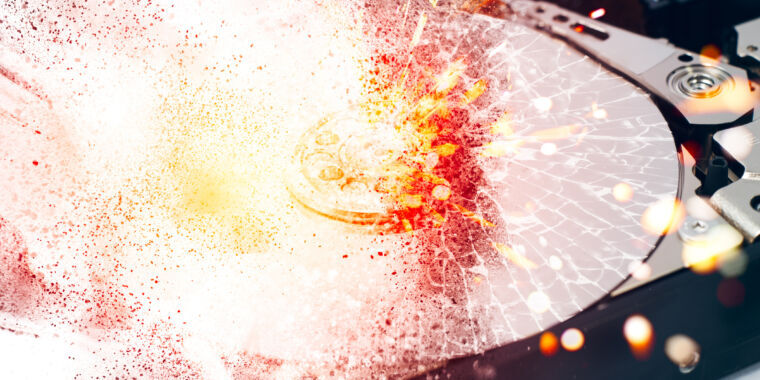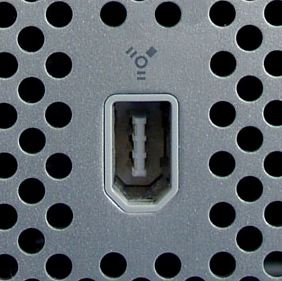- cross-posted to:
- [email protected]
- cross-posted to:
- [email protected]
My father told me he wanted to make USB flash drives of all the scanned and digitized family photos and other assorted letters and mementos. He planned to distribute them to all family members hoping that at least one set would survive. When I explained that they ought to be recipes to new media every N number of years or risk deteriorating or becoming unreadable (like a floppy disk when you have no floppy drive), he was genuinely shocked. He lost interest in the project that he’d thought was so bullet proof.
Buy Spinrite. It’s not perfect but it’s the best thing available for drive maintenance and recovery. I have used it for over 10 years. If the drive is dying it’ll take forever, but I’ve recovered data that was nearly gone due to sector loss. It goes down to the bit level BTW. Someday Steve will release v7 … someday.
This is the first time I’ve seen anyone else talk about SpinRite, known about it a long time too
If your data is really important, you should send it to a reputable data recovery service. Using the drive any more (even with a tool like SpinRite) risks further damage.
I think you are mistaken and don’t understand how Spinrite works. It reads at the bit level and only reads once at level 1. If the data is going to be lost at the first read then it’ll crash when read by a professional company.
Do you have a source for that? I am unaware of any modern hard drives that support reading individual bits; the minimum unit of data that can be read is generally one sector, or 512 bytes. If the sector fails to be read, the drive will usually attempt to read it several times before giving up and reporting a read error to the PC.
Data recovery companies can remove the platters from a damaged drive and put them in a working drive, as long as the platters are in good condition, preventing further damage. (If the platters themselves are damaged, you’re screwed either way).
This is the best I can find in a pinch. It’s possible it reads at the sector level and repairs at the bit level. It’s been awhile since I’ve been knee deep in Steve’s ass and testimonials. Old Security Now episodes have a lot of info on how it works.
https://www.grc.com/sr/faq.htm
Data recovery companies work the hardware which can be a point of failure. Spinrite tries to recover the data before the hardware fails. The greater density a disk has, the more failures are expected and error correction just assigns bad sectors as they fail. Between that and the OS, my understanding is that the slow degradation of a drive is managed until it can’t be. Even running Spinrite on a new drive is beneficial because new drives come with bad sectors. By assigning them as bad up front you get ahead of bad sectors and even can catch a lemon before it crashes. I’ve recovered unreadable drives with Spinrite. It’s impressive. It doesn’t solve all issues, but it’s really good.
I talk out of my ass at times, and the bit level statement could be one of them. Nevertheless Spinrite is a little known but amazing tool for HDD and SDD maintenance and recovery. Just go hop over to the forums. I used to be a member in them back in the late 2000s. You’ll see. There are deep drive nerds and they know their stuff.
My system is to duplicate to fresh media once in a while. It’s more hands on, but it’s the only option I have. My NAS will be cloned to new drives in the next few years.
You might want to look at snapraid. I’ve recently overhauled my own NAS and love it. It is snapshot based (so not perfect safety) but it is highly configurable and provides parity and scrubbing for corruption even with a JBOD array.
I’ll check that out. Thanks.
That’s the way to do it. Just keep bringing data forward even for media that sits in a drawer.
Yeah if you’re looking for long term it needs to be archival media. Many people think the flash drive will hold it forever but they are potentially the most fickle.
USB-A is best bet today, will live longer than other formats and USB adaptors will still exist when USB-A will disappear entirely.
Huh? USB is a connector, not an archival format.
Werent we talking about usb flash drives?
Since usb flash drives use usb, I think we can keep using them to store data in long term, rather than using floppy, cd or other analogic archive.The problem is that USB flash drives don’t keep their data intact for very long when they’re powered down. It lasts long enough for everyday use, but not even as long as a hard disk for archival.
when they’re powered down.
There’s no periodic cell refresh in flash memory like there is in DRAM. When USB sticks are plugged in, all you are doing is powering up the flash chip and interface ICs.
You’d have to read a block then write it back to actually refresh the stored charges in the cells.
Do SSDs do that automatically in the background, or is all the data I’m not actively refreshing gradually rotting away?
Oh, gotcha. Was thinking about the peripheral type support rather than its actual lifetime.
USB-C seems like it’s going to be around for a while.
There is also this thing called electron detrapping
But what actually is “archival”?
Like, what technology normal person has access to counts at least as enthusiast level archival?
Magnetic tape, optical media, flash, HDD all rot away, potentially within frighteningly short timeframes and often with subtle bitrot.
Like, what technology normal person has access to counts at least as enthusiast level archival?
Cloud storage? Store it on 2 different providers like B2 and iDrive or something, pretty low complexity.
You have to hope neither goes out of business either.
That’s why you have 2, there’s no solution for long term storage that requires zero checking on things that I can think of.
Is it? It’s rather expensive and would you really know, if the data is gone or corrupted?
You’d have to download every single file in certain intervals and check it. That’s not really low complexity.
I’ve got photos in Flickr dating from 1999 onwards. Ten thousand or so of them, and a couple of the early ones are now corrupted.
But they are my “other backup” for Google photos so I don’t mind too much. I also have a USB Blu-ray drive at home that I use to periodically burn M-Discs that I hand out to a few relatives.
That’s about as good as I can conveniently do for backup, and it’s probably better than the single-point-of-failure box of negatives that my parents have in their cupboard.
Good backup software will just do that as part of its thing, like Restic for example.
And who does that?
I think you don’t really get my point. I’m not arguing that there are no ways to archive data. I’m arguing that there are no technologies available for average Joe.
It is hardly a good strategy to basically set up half a datacenter at home.
Yeah that’s fair.
Common cloud storage such as google drive should be pretty resilient for the average person, data stored there is replicated in multiple data centers and verified with checksums, and it provides a trashcan and versioning in case of accidental deletion.
1960s style punch cards. Made of concrete.
I write these words in steel, for anything not set in metal cannot be trusted.
But it can be rusted.
Can’t spell trust without rust
Don’t address me informally.
Can’t say trusted without “usted”
removed by mod
IT WAS RIGHT THERE ALL ALONG.
Thin concrete slabs are extremely brittle.
deleted by creator
Holographic storage is a fluff project, the resolution we’d need to match modern density is simply to narrow to be done optically. I mean it sounds fun but will never be practical
deleted by creator
This is really the only way. Ironically not far off clay tabs just much much smaller.
M-DISC, at a guess. The media would last long enough at least for grandkids, who will have bigger things to worry about.
Don’t forget, you also need drives that work that long and connect to computers or some other device to utilize the bits, and the bus they use must be available and working, and the disk format they’re written in must be readable, and the images themselves encoded with an algorithm that we still have access to, etc. it’s not just the media.
I think it’s possible, thanks to the retro enthusiasts, we still have access to some things from the 70s and 80s, but they’re getting fewer and fewer, especially in a working state. That’s only 50yrs ago. What happens when you want to go 100? Or 500? A few thousand? We are familiar with journals from the Civil War, and have found items and notes from Egypt, Roman, and Ancient Greek civilizations, how can we preserve what happened in the currently information rich time we live in, for future generations? Especially as much of it migrates online to blog posts and social networks and news sites that eventually shut down due to corporate issues or shifting internet traffic?
Upload it to the cloud and make it someone else’s problem to deal with keeping up with the physical medium changes. Then your descendants only have to worry about figuring out how to deal with an outdated file format they can no longer open… and even when they can finally open it, it’d be super low quality… just like how we have to squint really hard at videos from VCDs now days.
There have been plenty of cloud services that have shut down and taken their data offline. And plenty of current ones deleted data after users have gone inactive. Or require constant payments to keep accounts active. Cloud, as it exits now, is not the answer to the archival question.
You’ll be very hard pressed to find anything else that’d out last the day when all three of AWS, Azure and GCP shutdown and take their data offline.
I get it though, Lemmy doesn’t want to admit these services exist other than to dunk on them in the most anti-corporate fashion… so continue to pretend such is the case!
They take your data down pretty quick when you die and stop paying for it. And as much as we all want to think AWS and GCP and Azure are sticking around forever there’s no reason at this time to believe they will be around in 100+ years.
Hard drives offer the best price/capacity ratio, but they need to be powered periodically (at least once or twice per year). As with any other storage medium, include parity data and have multiple backups to avoid data loss.
Tape is too expensive.
Optical media can also be pretty good as long as you get discs made from inorganic materials and store them properly. M-disc is supposed to last like 100 years. The biggest problem is that they are on the path to obsolescence and optical drives may stop being manufactured. Also, it’s a good idea to check on the condition of the discs periodically and redo any that shows signs of degradation (probably a good idea to replace non-M discs every 10 years regardless).
But regardless of the media, there is no archival method that doesn’t require active maintenance, like periodically checking the data, ensuring you have multiple backups, refreshing any aged media.
In my life I’ve had several HDD’s and SSD’s fail on me. None of that shit lasts forever and you would honestly be surprised how often they fail. For huge servers like data centers the average failure rate is between 1% and 2% per year, and sometimes even higher. They literally have to replace hard drives on a daily basis because of failure.
Disk failure is one of the reasons I have copies of all of my important stuff saved to every hard drive on my computer, along with an external just in case. One time my system drive failed and I couldn’t save anything because my operating system stopped working. Had to reinstall the OS and do a data recovery. Ended up with a bunch of photos that were corrupted, distorted, or missing half the photo.
I just replaced a drive today that has been running 24/7 for the last 5.18 years. It hadn’t failed yet but was in a predictive failure state due to the amount of bad sectors it has accumulated. 3 other disks in the same giant raid array are showing some bad sectors but not enough to be over the ‘replace me now’ threshold.
I have a feeling USB drives will be readable for a long time to come, considering that we still use the standard almoat everywhere, nearly 28 years after its introduction.
That said, copying the data from old archives into new formats is always a good idea
Edit: I was envisioning actual external hard disk or solid state drives accessible using a USB connection. Thumb drives and other ultra-portable data formats are notorious for poor data integrity over time.
I have a feeling USB drives will be readable for a long time to come
The drives may still be useful, but the data will long be gone. I have a flash drive from 06 that was last used in like 08 09 and most of it’s data was gone by 2019. The drive itself is fine. But what was on it has slowly faded away.
I’ve got several flash drives from 2 different brands that are less than 3 years old that are already dying. SanDisk and Lexar, both large brands and they’re already losing reliability. Real shame that the older stuff works longer. I really only need them for making Linux bootable drives and they struggle with that.
Note though that usb Sticks (if you mean that with USB drives) usually get the worst, cheapest quality flash. It’s a lottery, and expect nothing in no-name sticks.
* quality in yield, ssd > sd-card/emmc > flash sticks
This is where “piracy” is actually the industry’s saving grace. Decades or centuries later, will record labels exist and be well-managed (and flush with cash) enough to preserve archival copies of their artists catalogs? Probably not.
Will obscure weirdos exist all around the world on Usenet, IRC, or seeding torrents? Possibly.
What is really being discussed here is archiving of master recordings and session files. The publically avaliable releases themselves aren’t really in jeopardy. Orthough piracy probably does provide an extra layer of security to more obscure releases.
I thought I read somewhere that when they were making one of the Toy Story movies, there was some catastrophic data loss that nearly tanked the whole production. But then one of the animators came back from maternity and said wait, I think I have most of it synced to my home server? And the next thing you know, John Lasseter himself is barrelling down the highway to her place and it turned out yeah, she did have it.
The value of distributed redundancy
Something to be said for the wfh movement too.
Oh, fuck. Prince’s Vault… God I hope the estate has a plan to preserve all of that…
Many films and tv programs survive only thanks to a total stranger keeping their own copy. For a long term survival of any media it has to be copied and distributed far and wide.
I explained that they ought to be recipes to new media every N number of years or risk deteriorating or becoming unreadable
This is important, and for some media, it should be more often than that.
People forget that flash memory uses electrical charge to store data. It’s not durable. If left unpowered for too long, that data will get corrupted. A failure might not even be visible without examining every bit of every file.
Keep backups. Include recovery data (e.g. PAR2). Store them on multiple media. Keep them well-maintained (e.g. give flash drives power). Mind their environment. Copy them to new storage devices before the old ones become obsolete.
It’s funny that with all our technology, paper is still the most durable storage medium (under normal conditions) that doesn’t cost an arm and a leg.
Anything important, I write on clay tablets.
People forget that flash memory uses electrical charge to store data. It’s not durable. If left unpowered for too long, that data will get corrupted.
Yeah, but the link in the article, strict checks and no data loss over 52 weeks. Not neccessarily in USB sticks though. And sure, backups.
That number is a single manufacturer’s performance target. It is not a guarantee of results. You might be able to get Intel to replace an SSD if it corrupts data in under 52 weeks (assuming you notice it) but your data will still be gone.
Hardware performance can and does vary by manufacturer, model, and production run. Even the nominally identical cores within a single CPU have slightly different operating limits. YMMV.
Note also: the 52 week target you quoted is halved for every 5° rise in temperature.
It’s funny that with all our technology, paper is still the most durable storage medium (under normal conditions) that doesn’t cost an arm and a leg.
Sophistication often creates fragility. The human mind marvels at sophistication naturally; appreciation for resilience usually only comes after that fragile thing has broken. Of course it’s too late by then.
All them young whipper snappers will continue to learn these life lessons the hard way, it seems.
Tape backups, baby.
No, I don’t have a library of those. I don’t even have a tape drive.
This is my next step, i just wish tape drives werent so expensive.
If I had a cent every time an artist on patron had their computer die on them and lost works in progress or all their old stuff… I’d afford a few coffees.
Maybe you should have asked for a dollar everytime that happened. Youd be rich I tell ya!
To me, this is just another story of the music industry’s technical incompetence.
Even in the 1990s, everyone would have known that hard drives were not a long-term archival storage solution. This is like crumpling up a piece of paper, tossing it in the corner, then being upset decades later when your “archival solution” had issues.
The problem isn’t even the hard drives, it’s how they are managing them. There’s not many digital data storage solutions around that you can dump into a closet for a few decades and then still read.
You have to regularly test your hard drives, so that when one fails you can take your other copy of the data and put it on a new drive.
I’m sure they considered anyone telling them they needed to spend money to be a pain in the ass the same way companies don’t follow the recommendations of their IT departments.
The piece of paper is basically much more likely to survive in a corner barring a fire. I have crumpled pieces of paper from 20 years ago. My PATA hard drive… I don’t even have a computer with that connector
A bunch of paper tossed into a corner could get wet, mouldy, get munched on by rats, etc. But, I know what you mean. Spinning plates full of magnetized bits with a connector technology that only lasts a decade at most is hardly going to be reliable, even if stored under ideal conditions.
deleted by creator
These people haven’t heard of zfs then?
Zfs is just software raid, not an archival /backup solution. Sure, you can hold data on a zfs array for long term, but not without active maintenance (powering the drives periodically, replacing old drives, doing some kind of data refresh / scrubbing) and backups.
how music is so complicated to archive now
??
I still have a dvdr and good quality discs stored properly can last decades. Not perfect and harder and harder to find readers, but for long term backups its an affordable solution.
My family data vault has three dvdrs still in the box just in case 40 years from now you can’t find a drive.
That said, we will probably be moved beyond SATA then so…
I got four HDDs, some are almost 10 years old. They work great but I know that won’t be for forever.
I have probably lost lots of pictures die to head crash. WD especially
I only lost two HDDs in my life. Both in 2009. And yes, they were WDs
The only one that didn’t die because of my own fault (two externals and a laptop one sigh), was one of the infamous IBM/Hitachi Deathstars.
I’ve had many deathstars fail.
Old sysadmin trick I was taught was to freeze the drives overnight, have used this trick on multiple occasions, but once the drive heats back up it’s really dead. But you’ve generally got ample time to backup the drive before it dies.
Mine was a first generation one and as it was dying the first articles popped up about how bad they and the following generation were failing. Didn’t bother with warranty… wasn’t fond of gambling with the failure rates. Irony was that I named the drive Deathstar when I got it (I have the long standing tradition naming my drives after space ships).
Gonna remember that for the next drive failure. Isn’t condensation a problem with that trick?
Im really hoping, waiting, for a good dense long-term storage medium. It doesn’t have to be fast, but large, cheap, and durable. I want a way to backup my plex library, or even, daily backups of documents and project files, and I don’t want to think about them ever again.
Punch cards? Stored correctly there’s no reason they couldn’t last many human lifetimes. But… Yeah it’ll take a while to encode everything.
I would have thought that with modern technology we could come up with something like punch cards but more space/time efficient. Physical storage of data - only one write cycle of course, but extremely durable. Even just the same system as punch cards but using tiny, tiny holes very close together on a roll of paper. Could be punched or read by a machine at high speed (compared to a regular punch card, presumably still Ber slow compared to flash media).
Paper doesn’t last centuries. Anyway, punched cards don’t have a storage density that’s adequate for modern data volumes. You need something that’ll durably store nanometre-sized marks.
Yes that’s what I’m thinking, some modernised physical data storage technique.
I think you’re looking for stone tablets.
It does has to be fast enough that you can transfer the files to a different disk within your lifetime.
Do optical disks degrade if protected from the elements? A stack of Blu-ray disks could store quite a bit.
Depends on the disk technologies.
CDs are prone to flaking, otherwise most disk are suspectible of oxidation (disk rot) if stored improperly. M-Disk is a long-life variant of both DVDs and Blu-Rays, although more expensive. However, write-once disks are very ransomware-resilient, and I recommend to add a write-once media to any proper backup setup.
The commonly used optical disk technologies degrade over time. CD-RW more rapidly than CDR. It’s even worse for higher-density media.
And for bigger data sets, the capacity isn’t there. And writable media is getting more rare. Probably because of the same reason.
M-Disk is rated to last like
1001000 years. They are also working on a 125 Terabyte CD. Optical storage is the way to go.Was it sapphire or something? But one and done. I wonder if you could just keep writing and just “cross-out” the old stuff with that kind of capacity.
Not sure what sapphire means, but here is the article. Just appending records and differential backups would seem to be the way to go.
the new optical disks are claimed to be “highly stable so there are no special storage requirements.” The researchers tout an expected shelf life of 50 to 100 years
Sapphire was one of the materials being researched for optical data storage, once upon a time.
“Chinese researchers …”
OK.
Optical storage
so they’ve solved bitrot? nice
Well yeah but BluRay is still much more expensive and smaller capacity. Lets hope this new 125TB disk works out
The main cause of bitrot in older disks is the organic dyes fading (aside from REALLY cheap disks where delamination was a problem), whereas M-Disc uses an inorganic carbon material
TIL, thanks!
M-Disc is rated to last 1000 years.
deleted by creator
Tape is cheap and durable if you store it properly. Except the tape drive is expensive af.
Microsoft is working on glass storage. A glass plate can last 10,000 years according to Microsoft. Hopefully that tech will get miniaturized and available to consumers within our lifetimes.
Check out Cerabyte its for deep archinval storage
As a former audio engineer in the days where we still used it- tape can rot.
im not an audio engineer, but people didnt know this???
It seemed like the person I was talking to didn’t. The implication was that tape was viable as long-term storage. It isn’t. I’ve seen tapes rot after a year. DATs were especially prone to that, but even things like 2" multitrack audio tape can go bad that quickly.
It certainly would make planning the dang home lab easier. Im in a small place! I don’t have room for all the stuff i wanna play with!
Archive discs are that but not exactly cheap.
Well, nothing lasts forever. I’d say distributing them on something that lasts 10+ years is better than doing noting. Otherwise they just get lost, buried in the attic or the next harddrive crash takes them.
That shouldnt be all doom like.
Easiest thing is to make 2-3 copies of usbs and label the date the usb began its use, put a rough estimate on when the next generation should repeat the whole process until the pictures become irrelevent.
USB sticks and SSDs are no good for long-term storage. The data on them degrades rapidly if they’re not powered up. Spinning disks last longer. So your process would be better done with those.
Thats even better i didnt know that






















